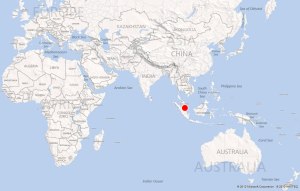On my recent quick trip to the United States, I had the opportunity and privilege to meet Singaporeans in San Francisco and speak about Singapore’s Financial Reserves and GIC. I had given much the same talk in the past to Singaporeans in Shanghai, New York, and London. There is no escaping knowing them to be Singaporeans once they begin to speak: It is the expressions and the welcome of home. All the Singaporeans invariably think of home, not just their memories of their childhood but their hopes for Singapore to be a great place – the best place – for Singaporeans. Singapore is a point of honour for them, an idea to defend, a home to protect, and a future to secure.
To understand why financial reserves are so important to Singapore, we need to understand geography and history. Less than 20 years ago, a foreign leader referred to Singapore as the Little Red Dot, a point Singaporeans should not be forgetting. If we look at a map of the world, Singapore fits into the letter “o” in its name, unlike many countries whose names fit nicely into their geographical boundaries on the map. And unlike some other small states, we have no natural resources. We are a little dot among states with large land areas and large populations. While Singaporeans may not like to be reminded of this, it nonetheless holds true that “no one owes us a living” and “no one else is responsible for our security.”
And to understand more deeply the need for large financial reserves, we need to remember history. Not everyone learnt history in school, and many who did stopped learning Singapore history in Secondary Four, if not earlier in Secondary Two. While there is the annual reminder on National Day of Singapore’s independence and sovereignty, what an adventurous and risky course Singapore took to “leapfrog” the immediate neighbourhood to link up to the whole world as our economic hinterland is often unspoken, perhaps little understood or even unknown by many Singaporeans.
The point about history is not to hold us back and hold us to the past – it is to give us context for what we need to do to make Singapore a great place for Singaporeans. We cannot escape our geography, but we can make good use of history to create a worthy future for ourselves and our families. It is a whole tapestry about Konfrantasi, water, sand, granite, and food.
When we know our history, we can be clearer about requiring our children to grow up with the capacity for thought, enterprise, and self-confidence to make a Singapore for their time. In addition, we will understand why business in Singapore needs to have its unique capacity for competing on the world stage founded on values of integrity, quality, reliability, imagination, responsiveness, and an unending drive for excellence.
I explained GIC as the fund manager for Singapore’s financial reserves, with the task of preserving and enhancing the value of the reserves, and of helping to contribute towards the government budget each year. The government is allowed to use up to 50 percent of the Net Investment Returns, calculated on the basis of expected long-term real returns multiplied by the net assets (that is, after deducting the liabilities like the special government securities that have been issued to the Central Provident Fund Board). For the next Financial Year, the government is taking into the expenditure budget a sum of $8.1 billion from the Net Investment Returns, which amounts to two percent of the Gross Domestic Product (GDP).
GIC ranks among the large sovereign wealth funds in the world with well over USD100 billion under the management of GIC. It invests in a whole slew of asset classes – equities, debt, real estate – in both the public and private markets, and in both developed and emerging markets across the world. It is headquartered in Singapore with eight overseas offices in Beijing, London, Mumbai, New York, San Francisco, Seoul, Shanghai, and Tokyo. A ninth office is also about to open in Sao Paolo.
An important question is how much of foreign reserves is enough. Obviously, the greater the needs and the more Singapore buys from the world, the larger the foreign reserves need to be. Thus an appropriate balance needs to be struck between spending on the current generation and keeping resources for future generations. The way this is done at present is the Singapore Constitution allowing the government to use up to 50 percent of the long-term real returns for ongoing expenditure, with the rest retained for continuing investment for the benefit of future generations.
Geography and history dictate the wisdom of Singapore maintaining a significant level of financial reserves in order to assure the peace, security, stability, sovereignty, and independence of Singapore.
For GIC to do its job well, we need a continuing flow of talent to perform the investment functions with skill and competence, and also to support the investment operations with efficiency and effectiveness. To this end, GIC offers about five scholarships each year for undergraduate studies anywhere in the world, and also runs an annual GIC Professionals Programme for up to 20 new who have just graduated from university or who have worked for up to 3 years after graduation.
In addition, GIC offers internships for large numbers of undergraduates each year so that they may get familiar with what GIC is about and can then decide whether they wish to consider a career in GIC.
More information is available on the GIC website: www.gic.com.sg. Enquiries from students and parents on the GIC Undergraduate Scholarships, GIC Professional Programme and GIC internships are always welcome: http://www.gic.com.sg/en/contact-us


